Why Having the Right Pickleball Paddles Makes A HUGE Difference
Pickleball, like any other racquet or paddle sport, requires that the participant become comfortable with the paddle as an extension of his or her own arm. After all, in pickleball, it is only through the use of your pickleball paddles (and you DO need more than just one) that you are able to propel the ball over the net! Want to learn more? Let’s dive in!!

Please note: This post contains affiliate links. An affiliate link means that we may earn advertising/referral fees if you make a purchase through our links.
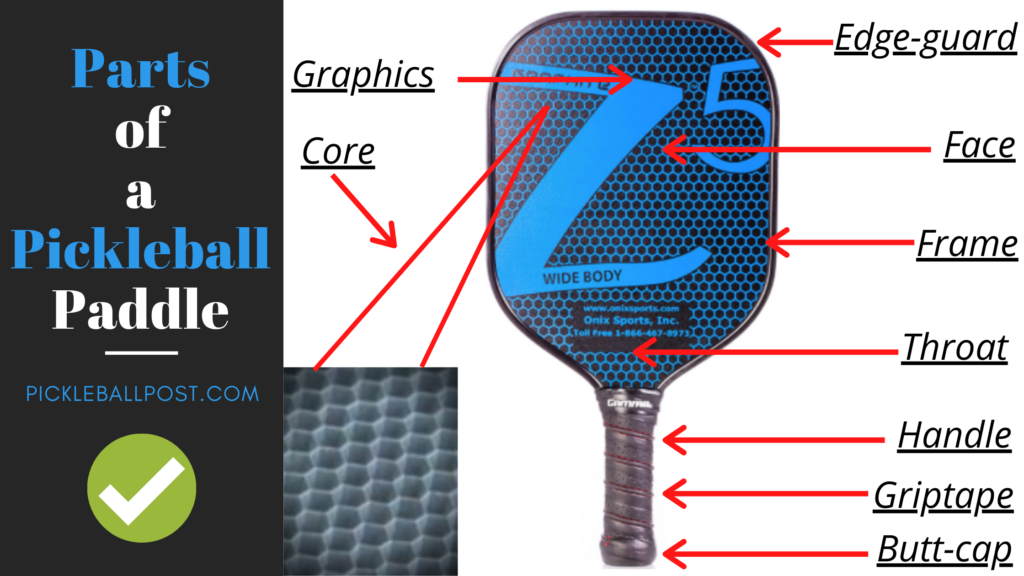
Just as every pickleball player is a little different than the next, each pickleball paddle is a little different than the next. To that end, there is no “one size fits all” pickleball paddle and each player should evaluate a number of different paddles to determine which one suites his or her own game. In most cases, you’ll find that there are many “right” paddles for you – one for spin, one for power, one for control, and so on. Don’t worry – we’ll get to that part!
The “right” paddle will make all the difference in your ability to prevail over your pickleball opponents! Consider the importance of the equipment to the end result – even a pickleballer with more experience and skill could fall to a lesser experienced, lesser skilled player if there was a mismatch in paddle quality or alignment with the player’s desired shot selection. Yes, a more talented player with a mismatched or inferior pickleball paddle would surely be defeated by a pickleballer who has mindfully matched their paddle with the demands associated with his or her own pickleball style.

In this guide, we are going to explain all of the numerous considerations that play a part in a pickleballer’s decision in terms of which pickleball paddle, or paddles, to add to his or her own bag. One must consider paddle weight, grip size, paddle size, the composition of the paddle (what it is made of), its ability to create or prevent spin, and countless other factors weighed against the pickleballer’s unique attributes, like playing style, age, mobility, history of injury and so on.
Does this sound overwhelming? Don’t worry, we keep it easy!! We are going to walk you through each and every factor to ensure that you and your pickleball paddle, or paddles, are a match made in pickleball heaven! After you read this article, you will be able to knowledgably wade through the innumerable offerings of paddles on the market to seek out the paddle best suited for you and your game! Ready to get started? I know I am!!
Pickleball Paddle Weight
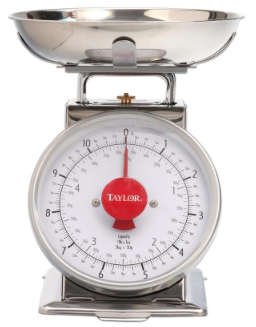
Please Note: As an Amazon Associate, I earn from qualifying purchases.
Ask any seasoned pickleball player and you’ll get the same answer – the weight of the pickleball paddle is the single most important factor. Why? The weight is going to impact your swing which, of course, directly impacts the shots that you’ll be able to hit as well as the impact of the swinging motion upon your arm and body.
(Commissions Earned)
You can find pickleball paddles ranging from ~6 oz (very light) to nearly 16oz (very heavy). Consider the impact of the weight upon your swing. A heavier paddle will carry more momentum through the shot and leave you better able to drive the ball into your opponent’s court. Of course, a heavier paddle may offer you less control and decreased stamina over an extended match.

Conversely, a lighter paddle will allow you significant flexibility and maneuverability, two features of tremendous importance to nearly every pickleballer. However, the light weight may decrease your ability to drive the ball for a “clean winner” and may also subject you to being overpowered by your adversary. Let’s take a look at some of the specifics typically associated with light, medium and heavy weight pickleball paddles.
Light (7.2oz or less)
Most pickleballers who opt for a lightweight pickleball paddle do so for a couple of key reasons – alignment with style, maneuverability, and lack of tennis elbow or other injury concerns.
A lightweight pickleball paddle will provide its user with a greater ability to use “touch” shots, meaning delicate shots (like drop shots), that require a heightened level of finesse. A heavier paddle, while resulting in more power, will suffer decreased finesse and control.

This type of paddle will allow for its user to be more reactive while taking a quickly approaching ball “out of the air” (e.g.: hitting a volley). The light weight allows the user to more quickly adjust the positioning and angle of the paddle so that the desired shot may be hit back across the net. A heavier paddle will necessarily be slower to react and may cost its user a point!
A lightweight paddle is better suited for pickleballers who do not suffer from, and who are not otherwise at risk for, a condition known as “tennis elbow”. A lightweight paddle will “transfer” more of the impact and shock from hitting a shot into the pickleballer’s elbow and arm – aggravating or even being the source of onset of tennis elbow. A heavier paddle would be better able to “absorb” this shock impact instead transferring the shock into the arm and elbow of the pickleballer.
This type of pickleball paddle is often best suited for those pickleballers who have a background in badminton or ping pong, as they are used to playing with a lighter weight paddle!
Medium (more than 7.2oz but less than 8.4oz)
Pickleballers who opt for a medium weight pickleball paddle do so for a handful of reasons – style of game, balance of maneuverability and power, potential tennis elbow or other injury concerns.
A medium weight pickleball paddle affords its user an ability to hit touch shots without the risk of an overpowering by their opponents. This balance is perfect, for example, when returning a serve from a power server, then electing to get to the net in time for a volley.
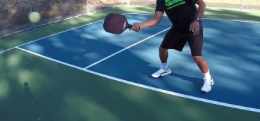
While not as maneuverable as a lightweight model, the pickleballer should still be able to add any number of “touch” shots to his or her own shot selection. It is completely reasonable for a pickleballer to expect that his or her own paddle will allow for a powerful return of serve, followed by a quick move to the net to put away a volley, even if it is coming at them at a high rate of speed!
Finally, with the increase in weight, the medium weight paddles are better able to withstand the shock and impact of each swing, keeping more of the impact in the paddle itself and sending less of it up the shaft into the user’s arm and elbow. In this way, it lessens the risk of tennis below more than a lightweight paddle, but less than a heavy weight paddle.
This type of pickleball paddle is usually best suited for a current or former tennis or racquetball player, as these players are more accustomed to heavier racquets and likely have built up a bit of tolerance to the tennis elbow condition!
Heavy (8.4oz or heavier)
The “heaviest” of the pickleball paddles is usually selected by users who are after a few different attributes – desire for more power, alignment with the user’s game (typically a doubles player), and reduced risk of tennis elbow.
A heavy pickleball paddle is going to deliver a bigger blow to the ball, even at a slower swing speed. This is why you see so many “senior” level pickleballers opting for the heavier models.
A pickleballer who predominantly plays doubles may well prefer a heavier model of paddle as there is less demand for drop shots and other finesse shots, and more demand to be able to combat your opponent’s power with that of your own.
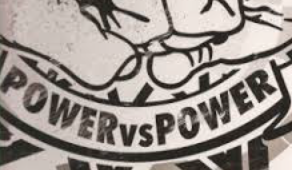
Of course, one of the biggest reasons to pick a heavy paddle is due to a user’s concern with tennis elbow or other condition (like arthritis). A heavier paddle is going to absorb more of the shock from a swing, transferring less energy up the paddle and into the user’s elbow and arm. Be advised, however, that the heavier paddle may also cause more swing fatigue than would a light or medium weight paddle. This is why the customization of paddle weight is so important to the user – like everything in this life, balance is key!
(Commissions Earned)
Typically, you’ll find that “senior” level players, or those who frequently play doubles rather than singles, are more likely to pick a heavy model of paddle. Often times, if not a senior or a doubles player, you’ll see that experienced tennis players opt for a heavy model, as it is more in line with the weight of a tennis racquet (which is much heavier than a pickleball paddle).
Pickleball Paddle Grip Size
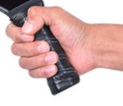
Aside from the weight of your pickleball paddle, grip size is going to be one of the most important considerations in your pickleball paddle selection process. There are a number of factors that go into determining which grip size is best for you, and getting it right is going to have a HUGE impact not only on what kind of shots you can hit, but your game as a whole!
Of note, the risks of picking the wrong sized grip could have SEVERE repercussions on your health in terms of injury. Just as using a paddle of improper weight can create or aggravate tennis elbow, so too can choosing an incorrect paddle grip size!
There are a few standard ways to ascertain grip size and we have covered them in great detail below. For starters, however, you should know that pickleball grips typically fall into a number of overarching categories: small, medium and large. Let’s take a look at the specifics of each of these types of paddle sizes below.
Small (Size 0 – 4″, Size 1 – 4 1/8″)
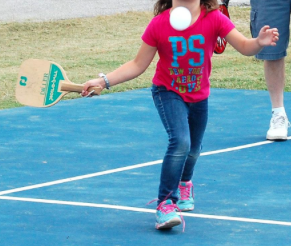
The “small” sized grips are most used by children, women, and those looking to add a ton of versatility to their game in terms of the increased wrist action permitted by the smaller grip size.
Medium (Size 2 – 4 1/4″, Size 3 – 4 3/8″)
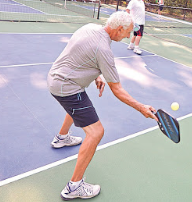
The “medium” sized grips are the most popular on the circuit, likely because they have been built to be rightsized for the average hand size of the average pickleball player. Of course, players with smaller hands can opt for larger sized paddles, just like players with larger hands can opt for smaller sized paddles.
The “medium” sized paddle is somewhat of a “best of both worlds” and can be customized by the addition of “overgrips” which we discuss later in this article.
Large (Size 4 – 4 1/2″, Size 5 – 4 5/8″)
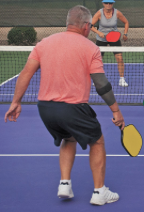
This is the “largest” size of pickleball paddle grips and is best suited for those with larger than average sized hands. It is VERY important not to opt for the “biggest” under the whole “bigger is better” idea, as doing so will almost certainly harm your game and may even cause injury.
There is a rule of thumb, of sorts, that you can always “build up” a smaller sized paddle grip with a couple of overgrips, but you can never decrease the size of your paddle grip if you make an errant selection to begin with! There is no pride here – get a paddle grip that is appropriately sized based on the size of your hands!
Building up a Grip with an “Over-Grip”
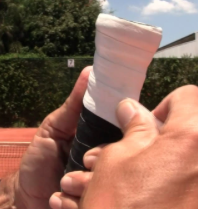
An “over-grip” is a type of wrapping used by pickleballers to improve the standard grips that come with the pickleball paddles. These type of grips can make the grip more “tacky” so that it is easier to hold onto, especially when your hand gets sweaty. It also provides just a little extra cushion and helps, to a very minimal degree, in terms of absorbing extra impact.
These type of grips are intended to function exactly how you might think. They are designed to sit quite literally “over” the existing “grip”. Did you catch that? They are designed such that the original grip of the pickleball paddle is NOT removed, you simply install the over-grip ON TOP OF the original grip.
(Commissions Earned)
Most overgrips are roughly 1/16thof one inch thick, especially when pulled tight during the wrapping process. You can use as many overgrips as you would like to “build up” the grip size of an otherwise small pickleball grip. The installation process is relatively easy, just start at the bottom and twist your way up the grip to create somewhat of a spiral.
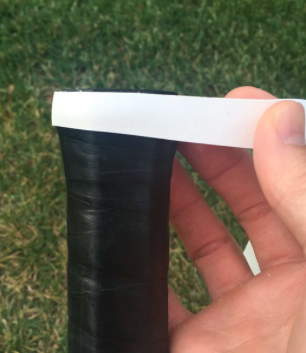
Once you get to the top, just cut and apply the tape (or rubbed band) that comes with the overgrip and you’ll be all set! Overgrips are designed to be replaced as they wear out. While it depends on your level of play, strength of grip, and amount of perspiration, you should reasonably expect a good quality over-grip to remain functional for at least 3-4 months.
But What Size of Pickleball Paddle Grip Size is Right for Me? Three Ways to Determine Hand Size:
With a Ruler
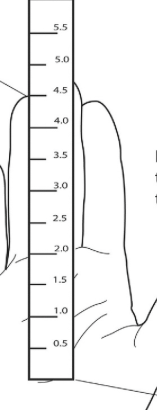
This is an easy one, and is best suited for those pickleballers who like to be very exact in terms of their grip size. Take your hitting hand (the hand you hold the paddle with) and place it flat on a table right in front of you with your palm facing up. Point your thumb directly out to the side, with the remainder of your fingers laying flat on the table and pointing away from you. All 4 of these fingers should be touching for the most accurate measurement.
Do you see the two lines in the center of your palm that run generally in a horizontal manner? Place the bottom of your ruler on the lower of these two lines such that the ruler lays up and down alongside your ring finger. Mark your ruler at the tip of your ring finger. The resulting number should very closely mirror your “ideal” paddle grip size! See, easy huh?!
With your Pickleball Paddle
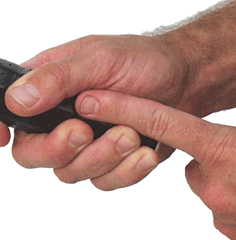
Have a partner hold your pickleball paddle right in front of you, grip first such that the grip is pointing right at your chest. Now, you need to reach out to it (with the hand that you’ll ultimately use to hold the paddle) as if you are going to “shake hands” with it, wrapping your finders around the grip in a comfortable, yet firm manner.
Now, taking the paddle away from your partner, locate the tips of your 4 fingers and the pad of your thumb. There will likely be some kind of a distance between the 4 fingers and the pad of your thumb. Your paddle grip is “ideally” sized when you can fit the index finger from your OTHER hand into such gap. If there is not enough room for your index finger to fit snuggly, your grip is too small. If there is a lot of left over space and your index finger can move side to side freely, your paddle grip is too large! Easy, right?!
Using your Height
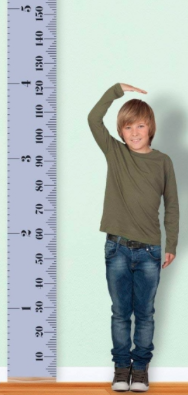
This one is a bit of an approximation, but it holds generally true if you don’t have other means to evaluate your grip size. It is said that the following heights correspond to the following grip sizes.
Shorter than 5’2″ = 4″ grip
Between 5’3″ and 5’8″ = 4 1/4″ grip
Taller than 5’9″ = 4 1/2″ grip
This approximation is by no means an exact science, and the sizes will vary a bit depending on whether the measuree is a male or female. However, if you have no other means by which to measure your hand size, then this one will do the trick:
Ricky Tip: When evaluating your grip size, always err on the smaller side. By this, we mean that if you are between a 4 1/4″ and a 4 1/2″ grip, you should ALWAYS go with the 4 1/4″ size and “build up” by adding one or two overgrips with the process we learned about above. You can always make your pickleball paddle grip bigger, but you can NEVER make it smaller!
Pickleball Paddle Hitting Surface Size
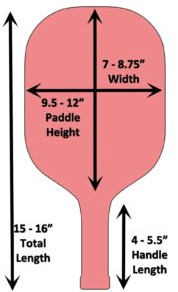
You should know that the USA Pickleball Association (USAPA) and the International Federation of Pickleball (IFP), the governing bodies of Pickleball, provide the following requirements with respect to the size of a pickleball paddle:
“Size. The combined length and width, including any edge guard and butt cap, shall not exceed 24 inches (60.96 cm). The paddle length cannot exceed 17 inches (43.18 cm). There is no restriction on paddle thickness.”
Because of those requirements, many manufacturers design their paddles to fall within the prescribed limits. However, some manufacturers disregard these rules and make pickleball paddles that fall outside of the allowed limits. Be very mindful of the surface size of your pickleball paddle, especially as you begin to compete in tournaments or leagues where these requirements and regulations are strictly enforced.
You’ll find several different shapes and sizes of pickleball paddle with each being better suited for players of different ages, styles, abilities, and so on. Primarily, the most popular styles fall into one of four categories: Wide, Oversized, Elongated, and Other. Let’s take a look at each of these styles one at a time below:
Wide Paddles
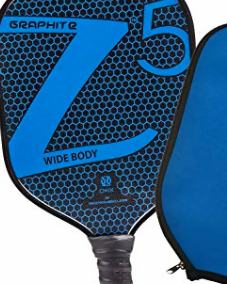
This is the style of pickleball paddle that you are likely most familiar with if you see people playing at local clubs or gyms and they “rent” their paddles from the facility. Why? It is because these were the first kind of paddles to really come onto the pickleball scene.
They measure roughly 8 inches across by just under 16 inches long (measured butt cap to top). This provides the player with a nice “square” surface from which to hit without sacrificing too much room in terms of the space allotted for the paddle grip.
(Commissions Earned)
Again, this is a very traditional style and it largely continues to exist in pickleball facilities across the nation, though it is beginning to see some increased competition from the styles outline below!
Oversized Paddles
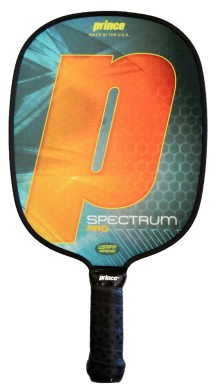
This is a type of pickleball paddle that has been designed with a wider face, coming at the expense of a shorter handle. In other words, manufacturers work to add more usable area to the paddle face, resulting in a larger amount of area to hit the ball, but they have to subtract some room from the grip and neck to stay within limits.
This type of paddle is very popular with beginners and those who do not require large size paddle grips. The increased hitting area makes it easier for those looking to find the sweet spot, though the quality of the sweet spot itself is somewhat diminished, even if the sweet spot does technically measure as larger.
Elongated Paddles
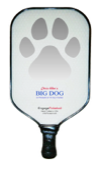
This type of pickleball paddle has become quite popular in recent years with the more “advanced” pickleball players. Perhaps its most noticeable feature is its narrower, but longer, face. It is shaped more similarly to an oval rather than a square.
(Commissions Earned)
This gives the more advanced player some additional reach, which becomes more important at the top tier levels of competition. However, a novice or beginner may have trouble using this kind of paddle and would be better suited by sticking with a wide or oversized paddle, like we highlight above.
These type of paddles are sometimes referred to as “blades”, instead of “elongated”, but there is no substantive difference. Just make sure that the paddle in which you have interest falls within the guidelines and that you can find the sweet spot – that’s what matters!
“Other” Paddles
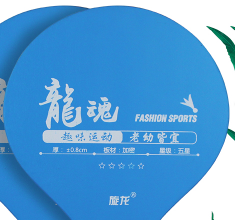
This category is meant to include all of the other types of pickleball paddle that you might run across at your local facility. They differ from the wide, oversized, or elongated paddles in any number of different ways. Many of them, in fact, differ to the point of non-compliance with the governing bodies and are not permitted in tournament or serious league play.
You might see that the paddle heads are diamond shaped, or even round (like a ping pong paddle). Some have super tailored and elongated necks, placing them in violation of the length requirement.
In any event, compliant or not, many users buy these types of paddles to make a statement or just have some fun! So long as you realize that you need to stay within the prescribed limits when competing, there is no harm in adding a “fun” paddle to your collection of pickleball gear!!
Pickleball Paddle Construction Materials
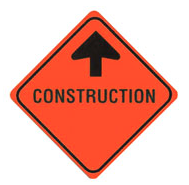
Ok, so you’ve decided upon the proper weight, have determined your grip size, and even know what style of paddle hitting area surface size you’d like, what is the next step?
You need to know that there are NUMEROUS different pickleball paddles on the market and the materials comprising each of them differ widely from one to the next. Let’s start by evaluating the materials making up the core of the paddle, then move onto to the materials making up the exterior (or face).
The Core
Wooden Pickleball Paddles
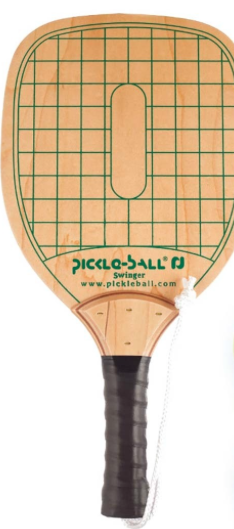
Pickleball paddles made of wood were the first ones to gain traction in the sport. In fact, they are still quite popular today and there is a good chance that if you “rent” a paddle from your local facility, it is going to be made out of wood!
Wood is a good material for its durability and price. A wooden paddle can take quite the beating over the years without a significant decrease in its level of performance. This is why it is the “rental” of choice at so many facilities! Also, so long as you make sure that it does not get (and stay) wet, there really aren’t very many maintenance requirements to ensure that you get a long life.
In terms of price, you can typically pick up a “pack” of wooden pickleball paddles on the cheap. They are great in terms of having “extra” paddles for when you are bringing extra friends along to play with your established group and they merely need something that will allow them to play for a couple hours.
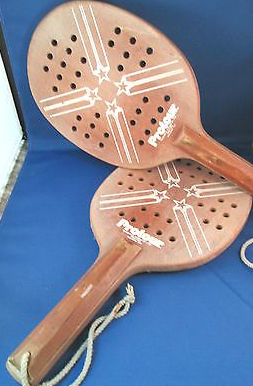
Most modern wooden pickleball paddles do include gripping and even a safety strap so that the paddle doesn’t turn into a projectile when your hand gets sweaty and it slips out of your grasp during a swing!
One major downside to wood, in addition to its performance for higher level pickleballers, and the noise associated with it, is its weight and shock-transfer. That’s right. A wooden pickleball paddle will weigh more than the styles highlighted below and will thus pose a risk to those with underlying health, injury or joint issues (like tennis elbow or arthritis). For that reason, we suggest that this subcategory of pickleballers choose a paddle made of something OTHER than wood, even for short durations, as doing so will reduce the wooden-paddle-weight-related risk of injury!!
Nomex Pickleball Paddles
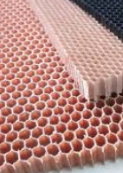
Have you ever heard of Nomex? Many, including most pickleballers, may not be familiar with this term. This is somewhat surprising, as the material has been around since the late 1960’s and is the backbone of a number of common products!
Nomex has the traditional “honeycomb” design, where the honeycomb cells are very tightly packed next to one another. This gives the Nomex based pickleball paddles tremendous “hardness”, once treated with resin, and durability to last for many seasons to come. The hardness results in a great ability to deliver power to each stroke, but may come at the expense of your ability to hit finesse shots on demand (though it is a better option than polymer when it comes to control shots).
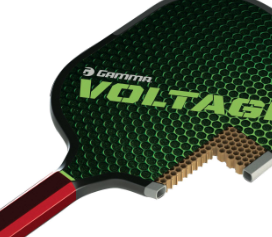
A Nomex based paddle is going to play “louder” than some other types of paddles due to the tightly oriented nature of the honeycomb cells. In fact, this is the material that produces the distinctive “whoop” when a pickleball is hit side to side over the net.
In our experience, you can always tell when a pickleballer is using a wooden paddle and a Nomex paddle based on the sound the paddle makes when the ball is hit. If you are looking for a “quiet” paddle, neither of these materials would be your top choice, as it is one of the loudest of all!!
Polymer Pickleball Paddles
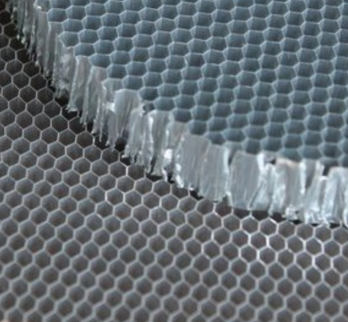
This is the most modern type of material comprising the cores of pickleball paddles today. You probably know that a “polymer” is a fancy name for a kind of blend of plastics. One of the differences between a polymer paddle and a Nomex paddle is that the honeycomb cells in the polymer style are not packed quite as closely together when compared to the cells in the Nomex paddle.
The more distant honeycomb cells result in a paddle that has a much “softer” feel upon impact than does a wooden model. This, of course, translates into a paddle that skews towards delivering the pickleballer some control, though at the expense of a little bit of power. Don’t let the loosely packed honeycomb deter you, however, as this type of paddle does have good durability to last you season in and season out for many years to come.
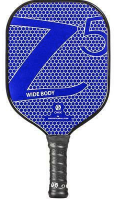
It does hit a little more “quietly” than do the wooden and Nomex models. In fact, if you are looking for the “quietest” pickleball paddle, then you’ll want to move forward with a polymer model. This, again, is due to the spacing of the cells.
These types of paddles are traditionally lighter than those associated with other types of paddles (wood, for example), and would thus serve as a good option for those with injury or joint concerns (such as tennis elbow). We suspect that we will continue to see an expansion of paddle offerings in the polymer category, as the material is easy to work with, very versatile, and is relatively cheap due to advances in mass production.
Aluminum Pickleball Paddles

If you want control, an aluminum-cored pickleball paddle is going to be one of your best options. Again, this is going to be built with a honeycomb design, much like the Nomex and polymer options described above, but it will have less power due to its weight and density.
An aluminum paddle will have denting concerns, however. This should be especially concerning from pickleballers who predominately play doubles as all to often do the paddles of partners collide with one another when reaching to manage a ball driven into the middle of the court. A few dints and dings, especially in the wrong spot and even if quite small, can seriously throw off the trajectory of an otherwise technically sound pickleball shot.
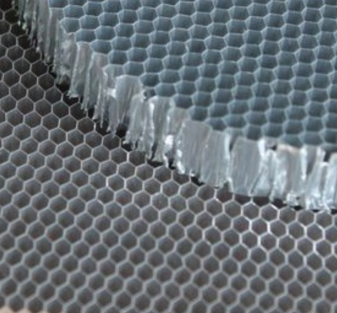
Another downside worth mentioning – These type of paddles tend to play quite a bit more “loudly” than the other types of models (second to Nomex). If you are not in a noise restricted club, and if you are more worried about control then power, then this type of paddle could be a great option for you! Just make sure that you are very mindful to avoid collision or contact with the paddle as dints and dings could require a quick replacement (as you are not able to repair them).
The Face
Graphite Pickleball Paddles
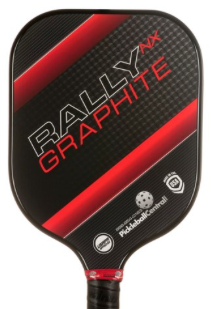
This type of pickleball paddle skews towards the lighter or middle weight category of paddles, usually in the 6oz – 9oz range.
This is a very popular type of paddle because it is light in weight, while remaining strong and providing its user an increased element of control. Don’t worry, the graphite covering is usually very, very thin, and it is found on both sides of the paddle.
Most pickleballers describe this type of paddle as being very “responsive” meaning that it has a nice blend of maneuverability and control, without scarifying all of your power. Be careful, however, as these type of paddles typically skew on the more expensive side, so if budget is your #1 concern, you may be better suited by looking at other options (like wood).
Fiberglass/Composite Pickleball Paddles
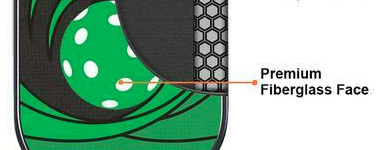
This is the type of paddle that you are most likely to find in the bag of an average pickleballer at your local facility. While it isn’t quite as strong as graphite (described above) or carbon fiber (which we evaluate below), it does provide its user with more power.
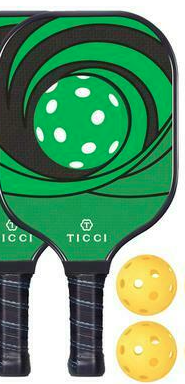
These type of paddles typically have a textured face which make them a favorite of those pickleballers looking to impose a little more spin on their shots. The texture allows for the paddle to “grab” the ball as the surface of the paddle brushes across it, allowing the user to spin the ball in any number of challenging ways. This type of spin simply isn’t possible with a wooden paddle, for instance.
Carbon Fiber Pickleball Paddles

A carbon fiber faced pickleball paddle is going to be more comparable to a graphite model (as opposed to wood or fiberglass/composite), but will be slightly more durable. If you are looking for the ultimate in ball control, then this is the kind of paddle that you’ll want to consider moving forward with.
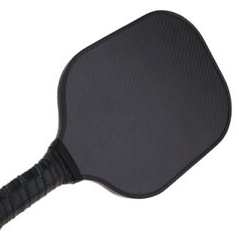
While you do gain more control, you are going to lose some power. This is where an evaluation of your game (and style of play) becomes very important. For instance, if you score most of your points on “finesse” shots (like drop shots), then you’ll want to look at carbon fiber paddles. However, if you like to win points by hitting “winners”, driving the ball out of your opponent’s reach before he or she can get there, then you need to look at a fiberglass model.
I Play at a Facility with Noise Restrictions – What Kind of Pickleball Paddle is Best?

Believe it or not, the noise associated with pickleball has become somewhat controversial in the recent years. This complaint has been voiced by club members and neighboring properties alike.
When a pickleball paddle makes contact with a pickle ball, there is a distinctive “whop” or “phop” sound created. With only one or two courts actively playing at any given time, this type of noise really isn’t that big of a deal. However, if there is a tournament occurring where many pickleballers are competing simultaneously and side by side, the noise can certainly become an issue, especially when echoed in an enclosed gym!
In terms of quietest to loudest, and given that there are exceptions to every rule based on the components of any individual paddle, you’ll find polymer and wooden paddles on the “quieter” end of the spectrum, with aluminum and Nomex paddles being on the “louder” end of the range.

Some communities, like the Sun City Grand Board of Directors, and countless private clubs, actually separate the world of pickleball paddles into two groups based on the sound associated with the paddle. They refer to this as the “Green Zone”, meaning certain paddles are permitted, and the “Red Zone”, meaning that certain paddles are NOT permitted – each due to noise.
Here is the important part, paddle manufacturers are increasingly looking to market to this specific opportunity by designating their paddles as “Green Zone” compatible. HOWEVER, as of the writing of this article, there is no nationwide pickleball standard for “Green Zone” and “Red Zone”, meaning that a paddle that may be “Green” at one club may very well be “Red” in another.

We suggest that you speak with the club director in advance of your purchase and have him or her sign off on the status of the paddle in which you are interested. Doing so could save you from buying a non-compliant paddle!
I want a Durable Pickleball Paddle. Which Types of Paddle have the Greatest Durability?
Pickleball paddles can be very expensive. Aside from cost, you want to be certain that your paddle will not let you down at an inopportune time! Because of these concerns, you want to make sure that the durability of the paddle you are evaluating aligns with your concerns.
Let’s look at a handful of ways that a pickleball paddle with poor durability might fail:
Poor Handle/Neck Design
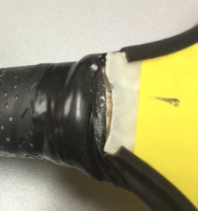
A pickleball paddle will generally have three identifiable features: a handle, a neck and a face. There is necessarily a great deal of strain on the neck, as it is the connection point between the handle and the face. That means, when force is applied to a ball, or when a paddle is swung through the air, the unsupported part of the paddle (i.e.: the neck, which isn’t supported by your hand on the grip) will strain.
Over time, the strain on the neck could lead to a weakening or even disconnection of the face from the neck or the neck from the handle. This will lead to a “wobble” that will be incredibly destructive to any pickleballer’s game and will ultimately necessitate the purchase of a new paddle!

Some manufacturers, predominantly those offering non-wooden paddles, have attempted to create a unified paddle where the grip, neck and face are all built of one molded piece. This will prevent any disconnection, but may also result in some performance concerns. While many are still working to solve this problem, the pickleball paddles at the upper end of the quality spectrum will last for many seasons without experiencing a “wobble”.
Exposure to the Elements

Pickleball paddles, like any other item, are subject to deterioration when exposed to the elements – mainly water and UV rays. As you might suspect, wooden paddles are particular susceptible to water damage as they can easily warp when allowed to become wet. Conversely, they are typically better able to withstand direct exposure to heat and UV rights.
Polymer paddles, like wooden paddles, should not be exposed to wet conditions without a quick drying, as you run the risk of a disconnect between the vinyl (or similar material) covering from the paddle’s core. If this happens, you’ll almost certainly experience dead spots that will impact your pickleball skill.
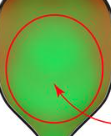
UV light would be very damaging to polymer paddle SAVE FOR the UV protective outdoor vinyl (or similar material) coverings that are applied to the face and neck of most high quality pickleball paddles.
Many paddles are “finished” with a solution known as “epoxy” which is known for its water and heat resistant properties. This type of coating provides a bit of a sealant, effectively insulating the inner workings of a paddle from the elements and definitely providing enhanced durability.
Dint, Dings, Chips and Cracks to the Edge
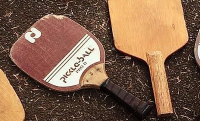
It is no secret that a competitive pickleballer will frequently bend low to retrieve and return a low ball. By no fault of the pickleballer, this swing will occasionally result with the paddle coming into contact with the hard surface of the pickleball court and will potentially result in damage (of varying severity) to the pickleball paddle!
While this type of contact is inherent in the game of pickleball, certain paddles have been designed to be less subject to damage whether through the materials constituting their core or frame, or by way of the installation of “protective” features (like edge-guards or protective coatings) that help the pickleball paddle withstand a little more punishment than it would otherwise be able to – thus increasing durability.
Edge-Guards
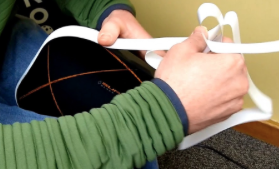
There are two main types of pickleball paddles – those with edge guards and those without. A typical edge guard (sometimes call a head guard, head tape or head ribbon), is essentially a thin strip of material (oftentimes plastic or rubber) that runs along the side of the face of the pickleball paddle, essentially serving as a protective barrier between the paddle and the surface of the court.

A rubberized edge guard will “grab” the surface of a court when brushed against such surface on a low shot, potentially disrupting the user’s technique. Conversely, a plastic edge guard will “slide” a bit more, allowing the user to finish his or her swing without significant disruption. This may lead you to believe that a plastic edge guard is preferred over its rubberized cousin, but plastic does have a downside.
Oftentimes, a plastic head guard is prone to cracking (especially with exposure to the elements and routine impact into the court over time). This will, sooner or later, require a replacement. A rubberized edge guard will usually last a little bit longer and, when the time does come for replacement, is a bit easier to replace than is the plastic style.
Edgeless Pickleball Paddles
In contrast to pickleball paddles that have edge guards, there are also TONs of “edgeless” pickleball paddles on the market. The only difference between edge and edgeless is, as you might have guessed, whether the paddle has a protective outer ring around it.
While the edge guard will protect a pickleball paddle against a number of dints, dings, scrapes and cracks, it can also interfere with your stroke. How? If you have an errant shot, one that is outside of the sweet spot, you will probably be OK unless it interferes with your edge-guard. If the ball does bounce off of your edge-guard, even just a little bit, the trajectory of the ball will be impacted.
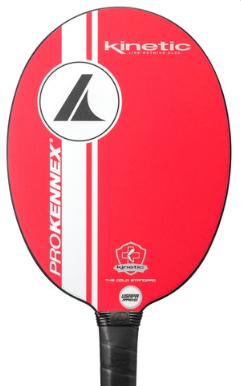
Some serious pickleballers swear by the small amount of additional surface area provided by playing with an edgeless pickleball paddle. Yes, it does leave their paddles more susceptible to damage, but it will also increase the surface area by just a little bit more.
Which style is right for you will depend on your playing style but, we would suggest that “beginner” level players always opt for a paddle that has an edge-guard, at least while starting out. It will protect your paddle investment just a little bit better – especially while you are getting used to the proper way to swing and maneuver around the court!
Protective Coatings

The durability of a pickleball paddle can be increased by way of the addition of epoxy (as discussed above) or a similar “hardening” agent. These type of protective coatings are usually “clear” so that they can be applied without taking away from the underlying appearance of the paddle.
A treated paddle will hold together for a longer period of time, being more resistant to water, heat, UV light, and other elements. It is our experience that a treated paddle will actually pay for itself over time, as its increased durability will result in a decrease of “repairs” or new paddle purchases over the years!
Consider a Pickleball Paddle’s Deflection
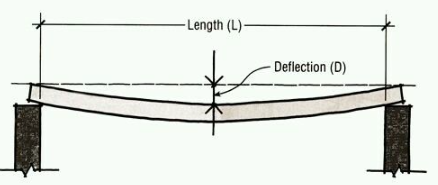
When you hear the word “deflection” in the context of pickleball, think of it as a measurement of the rebound or “bounce back” of the paddle. When pickleballer makes a stroke, the face of the paddle comes into contact with the ball, thus transferring the momentum of the paddle into the ball and powering the ball (hopefully) over the net.
Unlike in tennis, where a racquet can be strung to a different level of poundage per square inch (usually 55lbs to 65lbs), a pickleball paddle doesn’t have strings to bounce off of. Pickleball paddles undergo something known as a “deflection test” which is a means by which the rigidity and compressibility of the pickleball paddle is tested. Why?

In fact, USAPA Pickleball guidelines require that a ball not “sink” or “rest” into the face of a pickleball paddle, unlike in tennis where the ball does sink into the strings. Where a tennis racquet is string more “loosely”, the result is a trampolining effect that results in the racquet having more power. It doesn’t work like this in pickleball.
The paddle’s “deflection” metric is a score for you to evaluate whether a paddle is within compliance with the rules applicable to your pickleball outing. It is not, repeat NOT, a measurement of the paddle’s “pop” or power. As you have already learned in the sections above, a paddle’s “pop” or power is a function of paddle weight, the spacing of the honeycomb design of the core, and a number of other factors!
Color
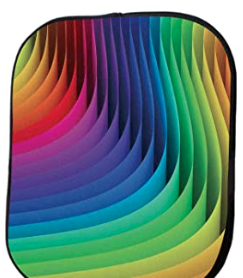
Here is a fun one! It doesn’t matter what kind of color or design you have on your pickleball paddle, so long as it isn’t one that could possibly interfere with your opponent’s ability to see the ball (like reflective paddle faces) and isn’t otherwise offensive or derogatory. Pickleball paddles come in any number of wacky and outlandish designs and colors!
The USAPA rules provide, in part, that:
“2.E.2.b. Reflection. The paddle’s hitting surface shall not be adversely reflective, such that it has the potential to negatively affect the vision of opposing player(s)”.

Most of these colors and designs are applied to the face of the paddle during a treatment process, ensuring that the pattern doesn’t “peel off” of the face after periods of extended use. This treating process usually involves epoxy or some other type of sealant, each of which have the added benefit of protecting your paddle from the elements.
Textured Faces on Pickleball Paddles
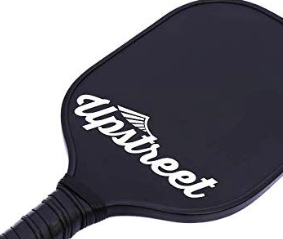
The face of the pickleball must be “smooth” by rule, meaning that it cannot have a certain level of indentations or “roughed up” spots that could be used to manufacture or enhance spin.
You can add decals or other designs to the face of your paddle, but you need to remember that the same texture rules apply.
The USAPA rules provide, in part, that, “Anti-skid paint or any paint textured with sand, rubber particles, or any material that causes additional spin…”
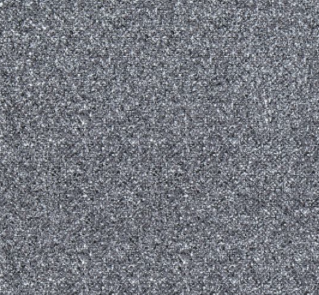
If you alter the texture of the face outside of a permitted range, you will not be able to compete in certain pickleball leagues or sanctioned tournaments.
In fact, the USAPA provides, in part:
“2.E.2. Surface. The paddle hitting surface shall not contain holes, indentations, rough texturing, tape, or any objects or features that allow a player to impart additional spin on the ball. Paddle roughness is determined using a Starrett SR 100 Surface Roughness Tester. The allowable limits for roughness shall be no greater than 30 micrometers (µm) on the Rz reading (average maximum height, peak to valley), and no greater than 40 micrometers on the Rt reading (maximum height, peak to valley).”
Price of Pickleball Paddles

Arguably the most important consideration among many pickleballers, particularly those who are just getting started in the sport and want to gauge their level of interest prior to spending a bunch of money on gear and equipment, is price.
Pickleball paddles, while not tremendously expensive, do vary widely in terms of price. The lower end, usually wooden, beginner level models can be found for $10 to $30. The top of the line models, which are frequently graphite, can go all the way up to $200!

The price that is right for you will truly depend on your own budget, but allow us to offer a couple pointers. If you are just getting started, you probably do not have the expertise required to use one of the more expensive models to its full potential. Because of this, you’d be better suited by buying something in the $35 – $70 range. This range will get you a paddle of enough quality to allow you to knowledgably evaluate your interest in the game to determine whether you want to invest in a more expensive paddle!
Once you determine that pickleball is the sport for you, you should consider investing in a more expensive paddle, and maybe more than one! Why? Every pickleball player is different from the next, and the qualities needed from one paddle to defeat a certain opponent may be different than the qualities needed in the next round of competition. Just as tennis players string numerous racquets at different levels of tension, so to do serious pickleballers who need to be able to adapt to the games of their opponents!

Also, if you are going to spend the money on nice paddles, we would suggest that you also buy pickleball bags within which to keep the paddles. Why? When your paddle is not in use, you will want to keep it tucked away safely into a pickleball bag to protect it from the elements. Remember, nothing will ruin a paddle faster than it being left out in the rain or exposed to the hot summer sun! Get yourself a basic pickleball bag, it will pay for itself over time in terms of damage avoided, trust us!
What is your Overall Skill Level in Pickleball?
Pickleball continues to boom in popularity! The sport is truly unique due to its cross generational appeal. For that reason, it is likely, even probable, that you are reading this post as a complete novice, determining whether to begin playing pickleball in the first place and, more importantly, how?!
In general, there are three different categories of pickleballer; beginner, moderate, and advanced. It is important to align your paddle with your skill level, but why? Just as a novice driver wouldn’t be able to avail themselves to the benefits of a race car, so to would a beginner pickleballer be unable to benefit from the advanced technologies in the more “pro level” pickleball paddles.
Considerations of Arthritis, “Tennis Elbow”, or Sports Related Injury
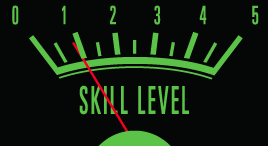
You will find that paddle weight is the single most important factor to consider when determining which paddle might be best for the pickleballer with underlying health, medical or injury concerns.
Arthritis
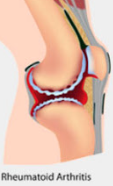
Arthritis can be a difficult problem to overcome, not just in pickleball but in any racquet sport. There are some rules of thumb but, the unfortunate reality is that each pickleballer’s condition and tolerance for pain will differ from that of the next.
In general, we have found that those pickleballers suffering from arthritis are better suited by opting for a lighter paddle. Why? Because lighter pickleball paddles are easier to maneuver and require less grip strength from the user. We also suggest that these pickleballers use a soft, yet tacky, over-grip to assist with getting good purchase on the pickleball paddle’s handle.
Tennis Elbow
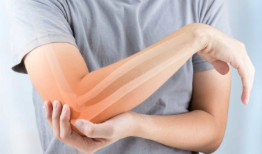
The condition known as “Tennis Elbow” is also somewhat tricky. Also referred to by the name “lateral epicondylitis”, and manifesting in all sorts of athletes OTHER than tennis players, this is a condition that stems from an irritation (usually overuse) of the tissue that connects your forearm muscle to your elbow. This usually occurs when someone uses repetitive arm and wrist motions, especially when combined with the shock of contact with a ball (like a pickleball).
Pickleballers seem to get over Tennis Elbow in a number of ways. Aside from rest, treatment and light pain medication, the weight of your pickleball paddle may play an important role. There are two leading theories. Let’s take a look at both of them in turn.
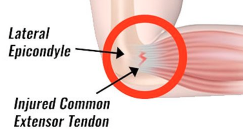
The first is that a lighter paddle is the better bet, as the paddle requires less muscle power to move and therefore imposes less strain on the underlying muscle and tendons. The downside of the lighter paddle is that it frequently is associated with a greater “impact transfer” from the ball, up the paddle and into the arm, thereby disturbing and irritating the joint.
The second theory is that a heavier paddle will help you come out of, or altogether avoid, Tennis Elbow. The idea is that the heavier weight of the paddle will help absorb some of the impact from the swing, thus transferring less impact up the paddle and into the pickleballer’s body. Of course, the heavier paddle can also be a detriment to an impacted pickleballer, with the excess weight placing additional strain on the wrist, arm and elbow.
Other Injury
Many pickleballers have elected to play pickleball because it is less physically demanding than some similar racquet or paddle sports (namely tennis). There are certainly advantages to pickleball in terms of lower body injury concerns (less court to cover), but we want to focus on the racquet vs. paddle discussion in terms of its impact upon the user’s arm and upper body.
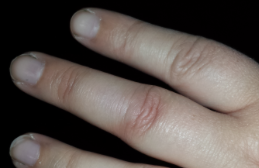
While every player is different than the next, the general rule is that the lighter the paddle, the better. There is an exception relative to Tennis Elbow (as we describe above), where a lighter paddle could end up causing more harm than good. Again, in general, you’d be better suited by gripping and swinging a lighter weight paddle as doing so will impose less strain upon your body.
We suggest that you opt for a pickleball paddle that has a more cushioned grip, as well, so long as it doesn’t significantly add to the weight. Why? A more cushioned grip will help absorb some of the “shock” from the impact ball contact, disallowing at least some of the shock from transferring from the paddle into the pickleballer’s hand, arm, elbow and shoulder. Also, the “tackier” the grip, the less pressure you will need to grip with to keep a good hold of the paddle. This will help those with injury related concerns as well.
Mobility Related Concerns and their impact on Pickleball Paddle Selection

When it comes to mobility, there are a couple different subcategories that need to be evaluated. The first is “mobility” as it relates to the pickleballer’s ability to maneuver the paddle quickly and with ease. The second “mobility” relates to a pickleballer’s legs and general conditioning and is important in terms of the impact upon a pickleballer’s playing style and shot selection.
Maneuverability
In pickleball, the ability of a player to be “quick” with the paddle is critical. This often leads players to select paddles that are on the lighter end of the spectrum – after all, these type of paddles require less wrist and arm action and allow a user to be quicker on the draw – to use a saying from my favorite western movie!
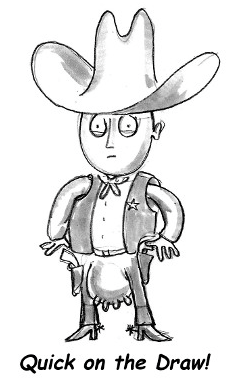
Remember, as we learned in the paddle weight sections above, even the heaviest of pickleball paddles aren’t tremendously heavy, and one can work to build up his or her strength such that he or she is just as quick with the heaviest models of paddle as they are with the lightest – rendering any maneuverability concerns as moot!
Mobility
Many pickleballer players have mobility concerns, but that does not mean that they cannot be exceptional and very talented pickleballers! It does, however, mean that they need to align their paddle selection to align with their game style and typical shot selection. What does that mean?
Pickleballers with mobility concerns are going to win points in one of two ways: By hitting a power winner (a hard shot hit beyond the opponent’s reach) or by hitting a finesse shot (usually a “drop shot” or other spin shot that an opponent is unable to get to before the second bounce).

A pickleballer who scores his or her points with power shots will typically want a heavier paddle, usually made of Nomex or polymer. Yes, these type of paddles typically come at the expense of some control, but if this kind of pickleballer wants to win a point quickly and thus diminish their mobility related concerns, then a power shot is going to win the day!
A pickleballer who relies on dinks, dunks, drop shots, spin shots and other shots requiring an increased element of control and finesse win points will typically want a lighter paddle with more “feel”. These type of paddles typically, but not always, come in the form of graphite or aluminum models. Yes, you do run the risk of being overpowered by a strong adversary, but you need to focus on absorbing their power and translating it into a finesse shot to win the point – a lighter model of pickleball paddle will help you do just that!
Do you Use your Pickleball Paddles to Play Doubles or Singles?
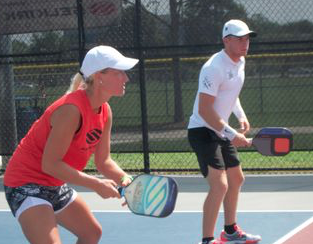
As pickleball fanatics, and if your budget allows, you’ll likely want to play with a number of paddles to align with a number of different types of game-play. One such game-play distinction is whether you are mostly a doubles or singles player. Why does this matter?
In singles, you are responsible for covering the court by yourself and you’ll need to use your “weapons” to win the points. If your weapon is power shots, then you’ll most likely benefit from the heavier paddles with the Nomex or polymer cores. If your weapon is spin or drop shots, then you’ll most likely benefit from the lighter graphite or aluminum models that translate into more “feel”.
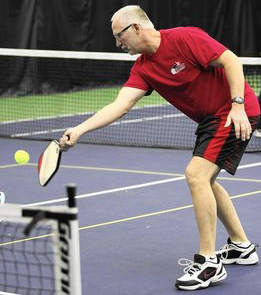
If you are a doubles player, you know that it is difficult to hit a shot, whether power or finesse, that extends beyond your opponent’s reach and results in a winning point. For that reason, you are more likely to beat your opponents by prevailing over them in terms of consistency and avoiding of “unforced errors” (a term which means you have simply missed a shot largely due to a reason of your own error and not because your opponent has hit a great shot).
This consideration leads most doubles players to opt for a lighter, graphite or aluminum model of pickleball paddle with which they feel they have the greatest amount of touch or feel. While, in general, this type of paddle is going to cost you some power – that’s not what you are after here! You’ll want a paddle that is going to help you outlast your opponents, making them commit the error before you do.

A side benefit of a lighter paddle, especially in doubles where the points tend to be longer, is that you will fatigue less both in individual points and over the course of the match itself. This is because the paddle is lighter in weight and takes just a little bit less energy from you during each swing! In a long and grueling match, you’ll definitely notice that a lighter paddle gives you a little edge!
What is your Preferred Shot Selection for your Pickleball Paddles?

Some pickleballers like to win their points with power, others with finesse, and still other by simply outlasting their opponents. Your paddle needs to align with your preferred shot selection. What does that mean?
If you like to drive the ball past your opponent, you’ll likely be better off by going with a heavier, Nomex or polymer model of paddle.
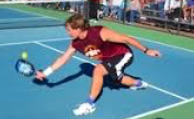
If you like to catch your opponent off guard with a spin or drop shot, you’ll probably be best suited by going with a lighter, graphite or aluminum model that provides you with more feel.
If you want to “outlast” your opponent, you’ll probably be happy with a medium or light weight paddle, each of which can help you with consistency and will better keep you from tiring out during long points and matches!
Do I Want to Win with Control or Power?

Power and Control are the two opposite ends of the pickleball paddle spectrum.
Typically, the more power associated with a paddle, the less control that will come along with it. Conversely, if you own a paddle that provides you with exceptional control, you probably have sacrificed a little power in exchange!
While there are tons of different kinds of pickleballers, resulting in an infinite number of playing styles and shot selections, we’ve found that you can always make up for a little bit of “lost” power by increasing your swing speed. Typically, however, you can not make up for “lost” control by decreasing your swing speed.

For this reason, if you can only buy one paddle, you are generally going to be better suited by purchasing a more “control” oriented paddle and working on increasing your swing speed for those situations when you need a little more “pop”. This gives you a little bit of the “best of both worlds” though, admittedly, when you increase your swing speed in an attempt to power up, you will likely compromise on form (unless you are very advanced), which could impact your ability to be consistent, resulting in more unforced errors!
Am I an Indoor or Outdoor Player?

The venues in which pickleball is played are increasing by leaps and bounds! Whether at your neighborhood court, your local park, the new pickleball facility down the street, or the health club out by the lake, one thing remains the same: the courts will either be indoors or outdoors. The indoor / outdoor setting will play an impact upon your pickleball paddle selection. Why?
Indoor pickleball courts frequently require “Green Zone” paddles (like you learned about earlier in this article) due to noise considerations. Because of this, you’ll want to check with your facility to ensure that your paddle, or the one that you are considering purchasing, is compliant.

Outdoor courts are going to leave your pickleball paddle more exposed to the elements, particularly UV right and rain. Because of this, you need to ensure that your paddle is treated with epoxy (or similar material), with sealants sufficient to keep it from quickly breaking down, or the creation of “dead spots”, due even to a minimal exposure to these elements!
Of course, when playing outdoors, there are two other considerations that come into play which we address in the following sections: Wind and Temperature. Let’s take a look at each of them in turn.
Do you Use your Pickleball Paddles in the Wind?
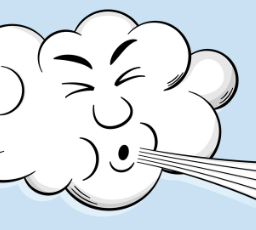
With more and more pickleballers scheduling indoor “court time” months in advance, its no wonder that so many are opting to take their passions outdoors. Moving the venue outdoors will, of course, subject you to potentially windy conditions! There are two schools of thought when it comes to combating the wind.
The first is that the pickleballer will benefit from a heavier, Nomex or polymer cored paddle. Why? These type of paddles will help the pickleballer impose more or his or her own will onto the ball, driving it through the wind more quickly and with more power such that the winds will have less of a chance to blow the ball out of bounds!
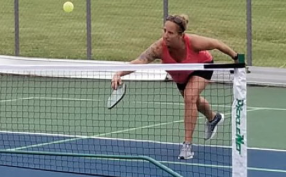
The second theory is that a pickleballer will benefit from a lighter, aluminum or graphite based paddle. There are a couple of reasons why.
First, these type of paddles are more maneuverable, due to their light weight, and thus a pickleballer will be better able to make last second adjustments to the ball when and if a sudden gust of wind blows the approaching ball in a new direction or on a new course.
Second, these types of paddles are typically considered to provide more “control”, allowing the pickleballer to use technique to spin and finesse the ball in a manner that defeats the wind. Some even like to take advantage of the wind, spinning the ball such that it blows into the wind for a drop shot or slicing the ball such that it travels with the wind, adding a “double whammy” to the ball and likely spinning it beyond the opponent’s reach!
Outdoor Temperature Considerations

While there is no such thing as a “hot weather” or “cold weather” pickleball paddle, there are some things that you’ll want to consider.
If you are playing outside, your paddle will likely become exposed to UV light. Prolonged exposure to UV light can damage pickleball paddles by causing them to heat up which could lead to the paddle-face covering separating from the honeycomb interior, effectively ruining your paddle.
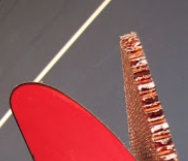
Remember, the honeycomb interior (unless you have a wooden paddle) is a highly specialized and sensitive material that is NOT built to be exposed to the elements. That is the reason for the paddle-face cover and the protective coating (usually epoxy). You should avoid leaving your paddle outside in the direct sun, keeping it in a protective bag instead.
Even if no separation of the face-cover occurs, you should know that exposure to UV light and heat can create “dead spots” on the paddle. These, of course, will throw off the shot of even the most advanced pickleballer. While hard to describe, a “dead spot” is somewhat of a dampened or flat-feeling area of the paddle where it feels like the paddle has simply lost its “pop”. Once this occurs, the damage is irreparable and you’ll need to spend money on a replacement paddle. Better to protect your investment by avoiding prolonged exposure to heat and UV light.

Also, when playing outside during the summer months, or even when playing inside for prolonged periods or during a particularly intense match, your hands will become sweaty! A pickleball paddle will quickly become a dangerous projectile if your grip becomes too sweaty and wet that it becomes slick and compromises your ability to keep a firm hold on the paddle. You can protect yourself and others by looking for a couple key features, each of which is outlined below.
Cushioned Pickleball Paddle Grip

All pickleball paddles come with a grip, but some are more “cushioned” than others. Not only does the amount of cushioning matter to those of use who are impacted by arthritis, Tennis Elbow, or other sports related injury, as described above, it will directly impact how well you can hold onto the paddle!
We suggest looking for a paddle that has a reasonable amount of padding, something that condenses just slightly when you grip it. I usually compare this to an amount of padding just over that amount of padding in a leather or cloth wrapped automobile steering wheel. Something that allows you to grab and squeeze, but not too much padding!

You also want your grip to be somewhat water resistant (so it doesn’t absorb your sweat) with a certain degree of tackiness (instead of one that is purely wooden and slips easily from your hands). Some paddles even feature a “pistol” grip, allowing you to wrap your index finger along the “trigger” and increasing your purchase on the paddle grip!
Over-Grip; Paddle Grip Tape
While the grips of many pickleball paddles are quite good to begin with, they do begin to wear over time. Luckily, there are tons of different types of “grip tapes” or “over grips” on the aftermarket that can be layered atop the existing grip to give the paddle that “new grip” feel.
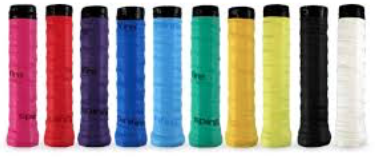
The best part? These type of grips are nice and tacky, water resistant, and won’t break the bank! They are easy to install, just start at the bottom of the handle and wrap our way around the shaft in an upwards and spiraling manner until you get to the top of the grip. Then, cut and secure it in place with the included tape, rubber band, or both! These can be replaced time and time again and are a great solution to sweaty hands!
Pickleball Paddles with Safety Loops
The best “fail safe” in terms of keeping your pickleball paddle from becoming a projectile during a shot is a safety loop. A safety loop is a very thin loop of material (usually leather) located at the very bottom of the flat part of the paddle grip. It is typically 10 inches in length, starting at the bottom of the paddle, going downward, and the reconnecting to the bottom of the paddle.

These features are meant to be placed around the pickleballer’s wrist such that, if the paddle does slip loose from your grip, the paddle is stopped by the safety loop, kind of like a paddle leash! They are very easy to use and you won’t notice it at all once you have it in place. Just slip your hand through the paddle loop, then grasp your paddle as you otherwise would. How about that for some peace of mind?! Safety first!!
What Kind of Pickleball Paddles are in my Price Range?

There are generally three prices range within which pickleball paddles are priced. While there are “good” paddles outside of the normal ranges, there are also “bad” paddles in such ranges. Because of that, you need to remember what you have read in this guide to direct you towards picking out the top quality paddle within the budget you have allotted to yourself.
Less Expensive Pickleball Paddles ($10 -$50)

In general, in this category, you will mainly find wooden pickleball paddles. You can also find some polymer or composite paddles in this range. You will almost never find a graphite model in this range.
This price is good for those who are deciding whether pickleball is right for them. You can find tons of reliable, albeit not very technologically advanced, paddles in this category and it’s a great starting point for beginners!
Medium Priced Pickleball Paddles ($50 – $130)

This “medium priced” category is inclusive of the vast majority of pickleball paddles on the market. You can find wood, polymer, composite, aluminum and graphite paddles in this price range.
This is the price range in which most “hobbiest” level pickleballers find their paddles. The selection is wide, the quality is good, and the features are advanced enough to provide these players with a slight edge over their competition.
Most Expensive Pickleball Paddles ($150 and Up)

This is going to include your “top of the line” pickleball paddles, many of which feature graphite and other high tech, performance driven materials. While it is very, very rare that you see a paddle priced at over $200, it is not unheard of.
Your typical buyer in this group is a very serious pickleballer, maybe even a professional. In fact, it is not uncommon to see that one pickleballer will have multiple of these “most expensive” categorized paddles in his or her own bag (often times of different styles (power, control, spin and otherwise)).
I Don’t Understand the Difference Between Fiberglass and Graphite Pickleball Paddles

Don’t worry! You are not alone in your confusion on this front! Many pickleballers, even those who have been playing for years, hear the term “graphite” paddle and they tell you that the core of the paddle is made of graphite, but that’s not the case, so let’s set the record straight!
In a graphite paddle, the actual graphite is applied as a layer atop the inner core of the paddle. Remember how we learned about cores like Nomex and polymer above? To make it even more complicated, graphite is a type of carbon fiber material (graphite is a form of pure carbon) and many pickleballers often call “graphite” paddles “carbon fiber” paddles. I know, I know, it gets pretty confusing!
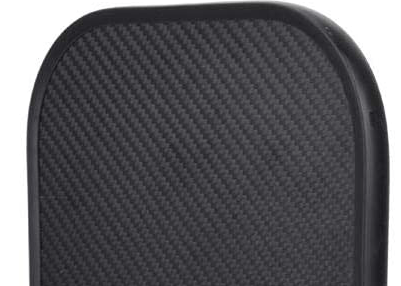
Graphite is super light and quite stiff (it can also be very brittle, so don’t think that there aren’t drawbacks). The lightness makes it great for pickleballers desiring enhanced maneuverability, as earlier discussed, and the graphite adds somewhat of a feeling of additional control upon impact.
When compared to fiberglass, you should know that a fiberglass model of paddle will have a bit more flexibility than a graphite model. So what is the result? The creation of a little more power, in the form of more deflection or “pop” of the ball off of the face of the paddle!
How Many Years Should I Expect to Get Out of My Pickleball Paddle?

The “longevity” of your pickleball paddle will, in part, depend upon how frequently you play and your playing style. Of course, the more frequently you play, and the more “damage” you impose upon the paddle, the quicker it is going to wear out on you.
While different paddles will last for different periods of time, a non-laminated wooden paddle is probably going to last the longest (so long as it is not exposed to water). A laminated wooden model will not last nearly as long, with the laminations being prone to separate over the years.
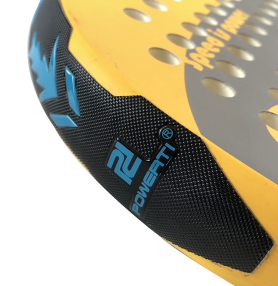
A head-guard or edge-guard will protect the integrity of any pickleball paddle and will thus serve to extend its longevity. Longevity is also preserved by keeping the paddle in a protective cover when not in use, keeping the paddle away from water, and not exposing the paddle to UV light or excessive hit for unreasonably long periods of time.
Under periods of very heavy use (numerous matches per week), with proper care, you should expect to get at least 6 months out of your average pickleball paddle. With a slightly lesser usage period (1 or 2 matches per week), you will likely get at least 1 year of life out of your paddle. At an even more sporadic use, you can reasonably expect to get 2 to 3 years out of your paddle.

Again, the duration and longevity of your pickleball paddle is going to be highly user dependent. Therefore, the above are only generalized rules of thumb. Just remember, though, in terms of maintenance and avoiding of damage, the nicer you are to your pickleball paddle – the nicer it will be to you in terms of lifespan!
Which Kinds of Pickleball Paddles Have the Best Sweet Spot?
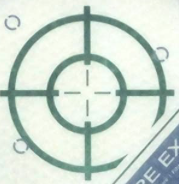
The core of the paddle is going to determine the type of “sweet spot” you feel when making good contact. Most paddles, other than wood, of course, are built with a kind of honeycomb engineering just under the covering of the face. Whether polymer, aluminum, Nomex or composite core, each paddles is going to have a sweet spot. Whether you can find it and reliably hit it is another story!
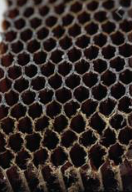
Nomex, for instance, is a little stiffer than polymer and will therefore have a more predictable sweet spot. Probably the most distinctive indicator of hitting a sweet spot is on an aluminum paddle, when you can literally hear the paddle make a slightly different sound on making true contact!
Is there a paddle with the “best” sweet spot? This will depend on your game and swing type but, in general, we have found that a Nomex core with graphite features is going to be at the top of the list for many players!
Is There a “Best” Pickleball Paddle?

We get this question all the time! By now, you have learned so much about pickleball paddles that you have surely learned that “the best” is going to be very dependent on a player’s preferred shot selection, mobility concerns, and abilities.
There is no single “best” pickleball paddle, but you will notice that many professionals and other advanced players will use paddles that include a Nomex or Polymer core, with some elements of graphite and fiberglass featured on the exterior of the core.

Remember, the “best” pickleball paddle is the one that you practice with and become comfortable using! What is the best for one player will almost certainly not be the best for another!

Never is this more evident than when you look in the pickleball bag of a top tier player. What will you find? NUMEROUS different pickleball paddles – some for spin, some for power, some for consistency, and so on. Each top notch paddle has its own specific features making it stand out from the rest! We encourage you to try as many different models and styles as you can, find out which you like, and then buy two or three of them so that you can adapt to any game-play situation!
Can I Buy Used?

Yes! That is the good news! There is a large market for used pickleball paddles and related gear. Do us a favor, you need to be very careful to only buy from reputable resellers. Be sure to ask a number of questions to make sure you are getting a quality used paddle (especially if you are buying sight unseen on the internet).
Has the paddle ever been exposed to water? Has its head guard ever been replaced? Has it been used mostly indoors or outdoors? How many seasons has the seller used it and, better yet, did he or she buy it new in the first place? What is the condition of the face covering? How about the grip? Have either such item every been replaced?

The more you can learn about the history and condition of the paddle, the better! After all, even though the paddle is used, there is a good chance that is relatively pricey! You want to make sure that you are spending your money wisely and that you won’t be back looking for another replacement paddle in the near future!
Pickleball Paddles – The Conclusion

WOW! That was a lot! By now you surely know EVERYTHING there is to know about pickleball paddles and you are one of the most knowledgeable consumers in the pickleball paddle space!
We learned about why having the right pickleball paddle makes all the difference! We covered different weights, grip sizes, overgrips, how to measure your grip size, the difference between wide, oversized and elongated models, and so on.

We then dove into the core of the paddle, discussing the differences between wooden, Nomex, polymer and aluminum models. We covered common construction materials in terms of the face, like graphite, fiberglass and composite.

We discussed the durability of the different styles of pickleball paddle, the different design types and the common breakages and downsides of each. We explained deflection rates, textures and the common ranges of pricing for the numerous types of paddles on the market.
We even included sections on noise limitations and considerations before getting into a discussion on what you ought to consider if you have arthritis, Tennis Elbow or similar concerns. We mentioned the importance of considering your preferred shot selection and whether you usually play indoors or outdoors.

We made sure to mention the different types and styles of grip that you commonly see, and even included a section on the importance of including a safety loop. We discussed the longevity you should expect and what kind of sweet spots each of the styles might have and why it depends on the player. We also spoke a little bit about the possibility of buying a used model of paddle while you are working to determine which one is “right” for you!
Comments

So what do you think? Did you find this guide to be extremely helpful in covering everything you could possibly want to know about pickleball paddles and what you should consider when you are thinking about buying one for yourself? Which models of paddle have you experienced? Do you have any opinions of your own about the best model for power, spin, reliability and so on? What about questions for us on topics that you’d like a little more detail on?
Please reach out to us and the rest of this pickleball community by posting on the Comments section below! We read and reply to every comment and love interacting with the pickleball community! We can all learn from one another and further grow the truly awesome sport that we love dearly!
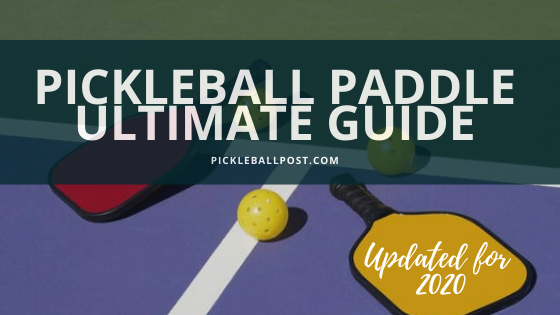





51 replies on “Pickleball Paddles – Ultimate Guide – Reviewed for 2020”
[…] question-and-answer section tackling some commonly asked concerns. Also be sure to check out our Pickleball Paddle Ultimate Guide for an extensive look at ALL the pickleball paddle options out there, if you’re not already […]
[…] into graphite paddles. Need a refresher on how graphite paddles are special? Head over to our Pickleball Paddle Ultimate Guide for that and more […]
[…] Not familiar with all the options out there? Be sure to have a look through our comprehensive Pickleball Paddle Ultimate Guide to learn […]
[…] performance. Not familiar with the variety of pickleball paddles out there? Check out our helpful Pickleball Paddle Ultimate Guide for a walkthrough of all the […]
[…] product availability. Not familiar with paddles in the first place? Be sure to take a look at our Ultimate Guide to Pickleball Paddles before reading this post! Let’s take a look at the results of both of these increases in […]
[…] composite category. Not familiar with all the different types of paddles? You can read up on our Pickleball Paddle Ultimate Guide to learn […]
[…] familiar with the differences between composite, graphite, and carbon fiber paddles? Check out our Pickleball Paddle Ultimate Guide for a full breakdown of these distinctions and […]
[…] This paddle, like its graphite counterparts, is a high ranker on one of our “best of” lists. The Niupipo Composite paddle is our runner up choice from our 5 Best Composite Pickleball Paddles of 2020 Review. If you need a refresher on the different types of paddles and playing techniques, head over to our Pickleball Paddle Ultimate Guide! […]
[…] familiar with the pros and cons of every type of paddle out there, be sure to check out our Pickleball Paddle Ultimate Guide, where we break down paddles, techniques, rules, and […]
[…] free to stop by our Pickleball Paddle Ultimate Guide while you’re at it, to learn even more about all the different kinds of paddles, helpful playing […]
[…] you’d like to review all the different types of paddles out there, we recommend going over to our Pickleball Paddle Ultimate Guide, where we explain various paddles, techniques, rules, and frequently asked questions about […]
[…] you want a detailed guide as to all the kinds of paddles out there, we’ve written a Pickleball Paddle Ultimate Guide to teach all the […]
[…] This Niupipo paddle is considered a fiberglass paddle. If you’d like to learn more about the other types of paddles out there — as well as some helpful tips to gain an edge on the court — head on over to our Pickleball Paddle Ultimate Guide! […]
[…] You can learn all about wooden paddles like this one, as well as other kinds of paddles, playing styles, and more if you head on over to our Pickleball Paddle Ultimate Guide! […]
[…] you’d like to learn more about other kinds of paddles out there, check out our Pickleball Paddle Ultimate Guide, where we break down the details of how various paddles perform differently, common playing […]
[…] If you want to learn more about other types of paddles out there, check out our Pickleball Paddle Ultimate Guide! […]
[…] To learn the pros and cons of different types of paddles — including wooden ones — check out our Pickleball Paddle Ultimate Guide! […]
[…] you’re curious about other kinds of paddles out there, check out our Pickleball Paddle Ultimate Guide, which we’ve written specifically to educate the pickleball public on what pickleball is all […]
[…] rather learn more about pickleball in general, we’ve written just the perfect guide — the Pickleball Paddle Ultimate Guide — which goes over the characteristics of different paddles, techniques, rules, and common […]
[…] If you need a refresher on the different kinds of pickleball paddles, playing techniques, and common concerns when it comes to the game, check out our Pickleball Paddle Ultimate Guide! […]
[…] If you want to refresh your memory on other types of pickleball paddles and playing suggestions, feel free to pause and head over to our Pickleball Paddle Ultimate Guide! […]
[…] out our Pickleball Paddle Ultimate Guide for more details on wide, elongated, and oversized paddles, as well as all other things […]
[…] In this review, we’ll tell you what kinds of players prefer edgeless paddles, as well as the five best ones we’ve found on the market today. If you’d like a refresher on all the different kinds of paddles, check out our Pickleball Paddle Ultimate Guide! […]
[…] — different paddle types, playing techniques, and frequently asked questions — head over to our Pickleball Paddle Ultimate Guide for more […]
[…] paddle types, playing techniques, and all other things pickleball, feel free to pop over to our Pickleball Paddle Ultimate Guide to learn […]
[…] learn more about the different paddle types out there — edged and edgeless — head over to our Pickleball Paddle Ultimate Guide, our comprehensive guide to all things […]
[…] a refresher on all the different types of paddles, playing styles, and more? Check out our Pickleball Paddle Ultimate Guide, our comprehensive directory for the sport of […]
[…] you head over to our Pickleball Paddle Ultimate Guide, you can find out even more about the best paddles for different playing styles and techniques, as […]
[…] our other top 5 lists or learn more about pickleball in general, browse our site and stop by our Pickleball Paddle Ultimate Guide for more […]
[…] out our Pickleball Paddle Ultimate Guide for info on other types of pickleball paddles, unique playing techniques, and […]
[…] you’re interested, there’s much more to the pickleball world — check out our Pickleball Paddle Ultimate Guide to learn more about pro paddles, playing tips, and […]
[…] you want to brush up on all things pickleball, we recommend you head over to our Pickleball Paddle Ultimate Guide for […]
[…] — the variety of different paddles, playing styles, and general tips — feel free to go to our Pickleball Paddle Ultimate Guide. We wrote it just for readers like you, to learn the history and playing practice behind this […]
[…] Or, want to know why one might need a quiet paddle over a loud one? Check out our Pickleball Paddle Ultimate Guide — we wrote it so you could have all the essential info about the game in one […]
[…] you want to learn more about the game, check out our Pickleball Paddle Ultimate Guide — which has all the basic info you need in one […]
[…] over to our Pickleball Paddle Ultimate Guide for more information on different types of paddles — loud and soft — as well as general playing […]
[…] paddles, the rules of the game, and all other things pickleball, be sure to check out our Pickleball Paddle Ultimate Guide for a full rundown of these details and […]
[…] out our Pickleball Paddle Ultimate Guide for details on other types of paddles, playing techniques, answers to frequently asked questions, […]
[…] if you’re looking for any other kind of paddle — browse our site and be sure to check out our Pickleball Paddle Ultimate Guide for even more pickleball […]
[…] Not sure what the difference is between graphite and carbon fiber paddles, or between indoor and outdoor pickleballs? Find answers in our Pickleball Paddle Ultimate Guide! […]
[…] more on elongated paddles, playing tips, and frequently asked questions, see our Pickleball Paddle Ultimate Guide — we wrote it just for […]
[…] It’s the last honorable mention in our 5 Best Pickleball Paddles for Spin post, so this paddle is also a particularly good spinner. We’ll break down all the details that we think make it a great fit for players looking for a high quality, easily maneuverable paddle. Want a quick refresher on all things pickleball paddle? Check out our Pickleball Paddle Ultimate Guide! […]
[…] — elongated, quiet, spin-oriented, and more — check out our archive of posts or drop by our Pickleball Paddle Ultimate Guide for all things pickleball in one […]
[…] you’d like to learn more about light, medium, and heavy weight paddles (plus more), check out our Pickleball Paddle Ultimate Guide — it’s a center for all things […]
[…] more your speed, or if you just want to find out more about pickleball in general, head over to our Pickleball Paddle Ultimate Guide for more […]
[…] for a paddle from a different weight category, make sure to peruse our site — including our Pickleball Paddle Ultimate Guide! It has all the basic information about every kind of paddle in one […]
[…] all the fuss is about when it comes to elongated, wide, or other types of paddles, check out our Pickleball Paddle Ultimate Guide! You’ll find all the details and more, all in one convenient […]
[…] you haven’t already, check out our Pickleball Paddle Ultimate Guide! There you can find all kinds of information about pickleball paddles, playing techniques, and more […]
[…] advice or information about other types of paddles, stay awhile to browse our site as well as our Pickleball Paddle Ultimate Guide! It’s your one-stop shop for all the basic info you need to get started with the […]
[…] to learn more about other types of paddles, including those for more advanced players, head to our Pickleball Paddle Ultimate Guide! It has all the important information you’d need to get started with the game, including playing […]
[…] But juniors aren’t the only ones who can benefit from paddles specialized just for them — browse our site for other paddle-specific lists, such as elongated and spin-oriented paddles. Or, if you want a one-stop shop for a general overview of pickleball, check out our Pickleball Paddle Ultimate Guide! […]